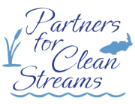
By Kyle Spicer
At the end of July, I was fortunate enough to attend the National Conference on Ecological Restoration in Schaumberg, IL. Before I get into that, I should tell you that I still consider myself the new guy. My two year anniversary of working with Partners for Clean Streams as the Project Coordinator is in November of this year, so I still have plenty to learn about in regard to the ins and outs of restoration projects. Yet, here I was, driving to Schaumberg to attend an international conference with an attendance list encompassing hundreds of representatives ranging from governmental organizations, nationally renowned agencies, and other nonprofits. I felt as if I was on a mission to tell the story of how a small nonprofit works to make big changes in the community we serve, one project at a time, through partnership.
The first few days of the conference flew by. Discussions and panels stressing the importance of best management practices in the agricultural regions of the Great Lakes, climate change, the Great Lakes Water Quality Agreement, multitudes of dynamic tools (both new and current) for monitoring and assessing ecosystem health, and urban ecosystem restoration. There were plenty of other topics with six concurrent sessions being held at the same time. Many attendees were bouncing between sessions to catch different speakers. It was a busy experience to say the least.
At first I was dismayed to see the agenda. I was to speak in one of the last sessions on Thursday afternoon, the fourth speaker in a panel of four discussing urban ecosystem restoration along with the difficulties and lessons learned. If you’re like me, you want to get stressful things done and over with. Having to wait days to speak on a topic you’re still getting comfortable with isn’t exactly, well, comforting. Looking back now, however, I think presenting later in the conference was rewarding.
All throughout the conference I was listening not to what the speaker was giving information on, but the context in which it was delivered. Things like where their project was done, how it affected the residents of a town downstream, and other socio-economic factors. I bet for every project even remotely connected to an urban environment, there are dozens of stories about the public raising concern. One of the greatest realizations I had during the week was the idea of giving an intrinsic value to the restoration you’re doing. Yes, it’s great for the environment, the Earth, and the people living next to the project area. The public knows that already. Calling something an environmental restoration project yields the connotation that it’s good for the Earth. What the average person really wants to know is “why I should care” and “what do I get out of it”?
That’s when I knew I had to adjust my presentation. The Camp Miakonda Project is the perfect example of how restoration and public value to the land can cooperate for the greater good (if you’re not familiar with the project, please check out our Projects page on the PCS website). Amidst all the conversations about lake excavation, in-stream erosion control structures, and wetlands remediation, there are a lot of secondary effects of the project for the Boy Scouts of America to be excited for. The number one improvement to Camp Miakonda is drastically improved access to both existing and new resources. Lake Sawyer is fishable and navigable again, the Ottawa River is exposed and safely accessible via an expanded path around the lake, and new outdoor classrooms capable of introducing youth to new ideas are abundant and currently being used.
This was my story to give and the reason I was attending the conference. Small nonprofit or not, everyone at that conference had a story to tell. Driving home I realized my story was just as important as a round table discussion on Asian Carp. The Earth is in our hands and one day our children will inherit it. I hope they will know why every effort, both big and small, is important because their turn is coming.
